Practice Question - 52 (Tables) | 100 DILR Questions for CAT Preparation PDF Download
There are only three female students - Amala, Koli and Rini - and only three male students - Biman, Mathew and Shyamal - in a course. The course has two evaluation components, a project and a test. The aggregate score in the course is a weighted average of the two components, with the weights being positive and adding to 1.
The projects are done in groups of two, with each group consisting of a female and a male student. Both the group members obtain the same score in the project.
The following additional facts are known about the scores in the project and the test.
- The minimum, maximum and the average of both project and test scores were identical - 40, 80 and 60, respectively.
- The test scores of the students were all multiples of 10; four of them were distinct and the remaining two were equal to the average test scores.
- Amala’s score in the project was double that of Koli in the same, but Koli scored 20 more than Amala in the test. Yet Amala had the highest aggregate score.
- Shyamal scored the second highest in the test. He scored two more than Koli, but two less than Amala in the aggregate.
- Biman scored the second lowest in the test and the lowest in the aggregate.
- Mathew scored more than Rini in the project, but less than her in the test.
Q1: What was Rini’s score in the project?
 View Answer
View Answer 
Ans: 60
It is given that there are only three female students - Amala, Koli, and Rini - and only three male students - Biman, Mathew, and Shyamal - in a course.
It is also known that the aggregate score in the course is a weighted average of the two components, with the weights being positive and adding to 1.
Let the project score component be x, which implies the test score component will be (1-x). The projects are done in groups of two, with each group consisting of a female and a male student, which implies there are three groups for the project. It is also known that both the group members obtain the same score in the project. The score obtained in the project is 40, 60, and 80, respectively.
Therefore, we can say that each female student will consist of a different group, and no two male students or female students will be in the same group.
For the test scores, there are six scores given for six students among which four are distinct and the remaining two are average scores, which is 60. It is also known that the maximum score possible is 80, and the minimum score is 40.
Hence, the distinct scores are 80, 70, 50, and 40 (since all the test scores are multiple of 10), and the remaining two scores are 60, and 60, respectively.
From point 3, we know that Amala’s score in the project was double that of Koli in the same, but Koli scored 20 more than Amala in the test. Hence, we can say the score obtained by Amala in the project is 80, and the score obtained by Koli is 40, which implies the score obtained by Rini in the project is 60. Now, Koli scored 20 more than Amala in the test, which implies the score obtained by Koli can be either 80, 70, or 60.
The score obtained by them is given below: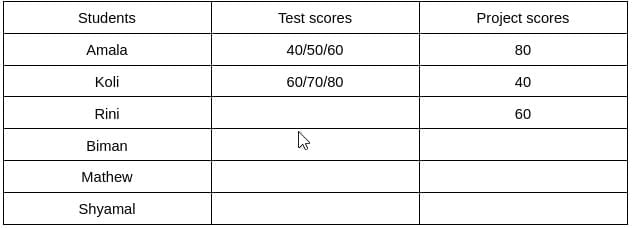 It is known that Amala had the highest aggregate score, and Shyamal scored the second highest on the test. He scored two more than Koli, but two less than Amala in the aggregate.
It is known that Amala had the highest aggregate score, and Shyamal scored the second highest on the test. He scored two more than Koli, but two less than Amala in the aggregate.
Hence, the score obtained by Shyamal in the test is 70, which implies Koli can't score 70 in the test => Amala can't score 50 in the test.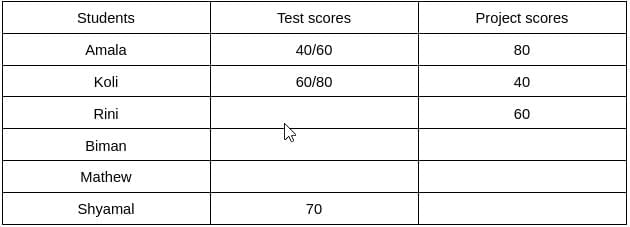 It is given that Shyamal scored two more than Koli, but two less than Amala in the aggregate. Hence, the aggregate score of Amala is 4 more than Koli. It is also known that Amala had the highest aggregate score.
It is given that Shyamal scored two more than Koli, but two less than Amala in the aggregate. Hence, the aggregate score of Amala is 4 more than Koli. It is also known that Amala had the highest aggregate score.
Case 1: The test score of Amala is 40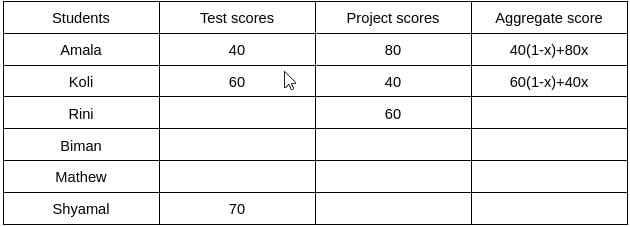
Therefore, 40 (1- x) + 80x = 60 (1 - x) + 40x + 4
⇒ 60x = 24
⇒ x = 0.4
Hence, the aggregate score obtained by Amala is 40 (1 - 0.4) + 80 * 4 = 56
The minimum aggregate score of Shyamal is 70 (1 - 0.4) + 40 * 0.4 = 58, which is greater than Amala.
Hence, Case 1 is not possible.
Hence, the table is given below: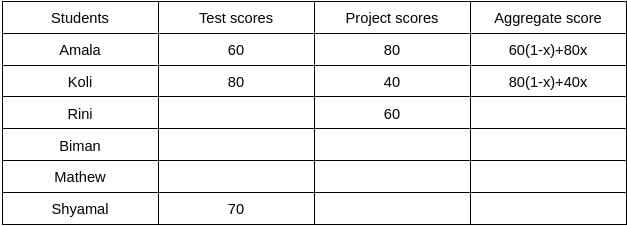 Therefore, 60 (1 - x) + 80x = 80 (1 - x) + 40x + 4
Therefore, 60 (1 - x) + 80x = 80 (1 - x) + 40x + 4
⇒ 60 + 20x = 84 - 40x
⇒ 60x = 24
⇒ x = 0.4
Hence, the aggregate score of Amala is 60 (1 - 0.4) + 80* 0.4 = 68, which implies the aggregate score of Shyamal is (68 - 2) = 66
Hence, the score obtained by Shyamal in Project is {66 - 70 *(0.6)} / 0.4 = 60.
It is also known that Biman scored second lowest in the test, which implies the score of Biman in the test is 50, and he scored the lowest in the aggregate. It is also known that Mathew scored more than Rini in the project, but less than her in the test. Hence, Mathew scored 80 in the project (since Rini scored 60 in the project), and Biman scored 40 in the project.
Similarly, Rini Scored more than Mathew on the test, which implies the score obtained by Rini is 60, and the score obtained by Mathew is 40 in the test.
Hence, the final table will look like this: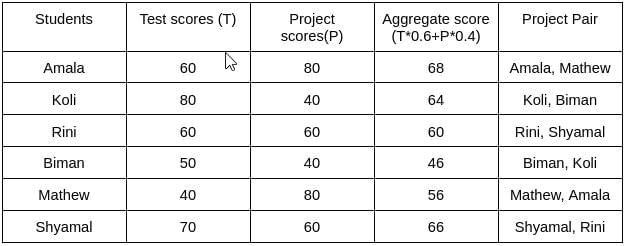 Hence, the score obtained by Rini in the project is 60
Hence, the score obtained by Rini in the project is 60
Q2: What was the weight of the test component?
(a) 0.60
(b) 0.50
(c) 0.75
(d) 0.40
 View Answer
View Answer 
Ans: (a)
It is given that there are only three female students - Amala, Koli, and Rini - and only three male students - Biman, Mathew, and Shyamal - in a course.
It is also known that the aggregate score in the course is a weighted average of the two components, with the weights being positive and adding to 1.
Let the project score component be x, which implies the test score component will be (1 - x). The projects are done in groups of two, with each group consisting of a female and a male student, which implies there are three groups for the project. It is also known that both the group members obtain the same score in the project. The score obtained in the project is 40, 60, and 80, respectively.
Therefore, we can say that each female student will consist of a different group, and no two male students or female students will be in the same group.
For the test scores, there are six scores given for six students among which four are distinct and the remaining two are average scores, which is 60. It is also known that the maximum score possible is 80, and the minimum score is 40.
Hence, the distinct scores are 80, 70, 50, and 40 (since all the test scores are multiple of 10), and the remaining two scores are 60, and 60, respectively.
From point 3, we know that Amala’s score in the project was double that of Koli in the same, but Koli scored 20 more than Amala in the test. Hence, we can say the score obtained by Amala in the project is 80, and the score obtained by Koli is 40, which implies the score obtained by Rini in the project is 60. Now, Koli scored 20 more than Amala in the test, which implies the score obtained by Koli can be either 80, 70, or 60.
The score obtained by them is given below: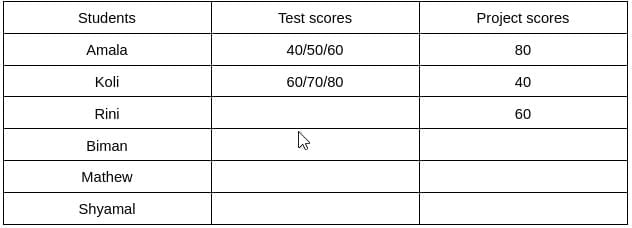 It is known that Amala had the highest aggregate score, and Shyamal scored the second highest on the test. He scored two more than Koli, but two less than Amala in the aggregate.
It is known that Amala had the highest aggregate score, and Shyamal scored the second highest on the test. He scored two more than Koli, but two less than Amala in the aggregate.
Hence, the score obtained by Shyamal in the test is 70, which implies Koli can't score 70 in the test => Amala can't score 50 in the test.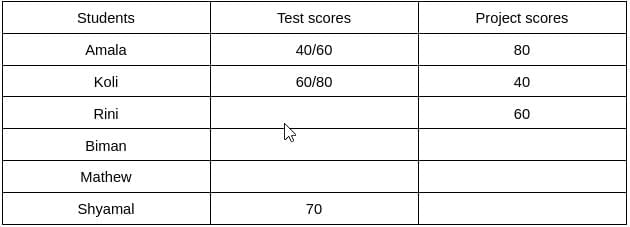 It is given that Shyamal scored two more than Koli, but two less than Amala in the aggregate. Hence, the aggregate score of Amala is 4 more than Koli. It is also known that Amala had the highest aggregate score.
It is given that Shyamal scored two more than Koli, but two less than Amala in the aggregate. Hence, the aggregate score of Amala is 4 more than Koli. It is also known that Amala had the highest aggregate score.
Case 1: The test score of Amala is 40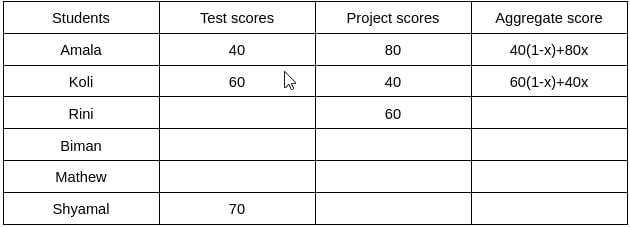
Therefore, 40 (1 - x) + 80x = 60(1 - x) + 40x + 4
⇒ 60x = 24
⇒ x = 0.4
Hence, the aggregate score obtained by Amala is 40 (1 - 0.4) + 80 * 4 = 56
The minimum aggregate score of Shyamal is 70 (1 - 0.4) + 40 * 0.4 = 58, which is greater than Amala.
Hence, Case 1 is not possible.
Hence, the table is given below: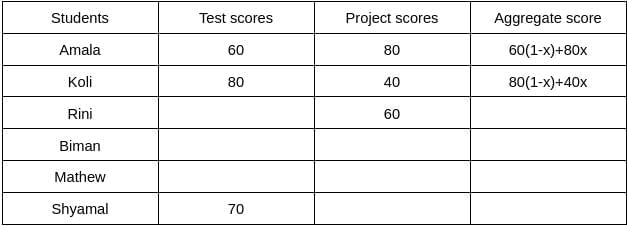 Therefore, 60 (1 - x) + 80x = 80 (1 - x) + 40x + 4
Therefore, 60 (1 - x) + 80x = 80 (1 - x) + 40x + 4
⇒ 60 + 20x = 84 - 40x
⇒ 60x = 24
⇒ x = 0.4
Hence, the aggregate score of Amala is 60 (1 - 0.4) + 80 * 0.4 = 68, which implies the aggregate score of Shyamal is (68 - 2) = 66
Hence, the score obtained by Shyamal in Project is {66 - 70 * (0.6)} / 0.4 = 60.
It is also known that Biman scored second lowest in the test, which implies the score of Biman in the test is 50, and he scored the lowest in the aggregate. It is also known that Mathew scored more than Rini in the project, but less than her in the test. Hence, Mathew scored 80 in the project (since Rini scored 60 in the project), and Biman scored 40 in the project.
Similarly, Rini Scored more than Mathew on the test, which implies the score obtained by Rini is 60, and the score obtained by Mathew is 40 in the test.
Hence, the final table will look like this: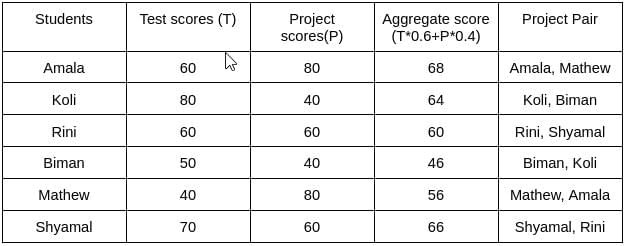
Hence, the weight of the test component is 0.6
The correct option is A.
Q3: What was the maximum aggregate score obtained by the students?
(a) 68
(b) 80
(c) 62
(d) 66
 View Answer
View Answer 
Ans: (a)
It is given that there are only three female students - Amala, Koli, and Rini - and only three male students - Biman, Mathew, and Shyamal - in a course.
It is also known that the aggregate score in the course is a weighted average of the two components, with the weights being positive and adding to 1.
Let the project score component be x, which implies the test score component will be (1-x). The projects are done in groups of two, with each group consisting of a female and a male student, which implies there are three groups for the project. It is also known that both the group members obtain the same score in the project. The score obtained in the project is 40, 60, and 80, respectively.
Therefore, we can say that each female student will consist of a different group, and no two male students or female students will be in the same group.
For the test scores, there are six scores given for six students among which four are distinct and the remaining two are average scores, which is 60. It is also known that the maximum score possible is 80, and the minimum score is 40.
Hence, the distinct scores are 80, 70, 50, and 40 (since all the test scores are multiple of 10), and the remaining two scores are 60, and 60, respectively.
From point 3, we know that Amala’s score in the project was double that of Koli in the same, but Koli scored 20 more than Amala in the test. Hence, we can say the score obtained by Amala in the project is 80, and the score obtained by Koli is 40, which implies the score obtained by Rini in the project is 60. Now, Koli scored 20 more than Amala in the test, which implies the score obtained by Koli can be either 80, 70, or 60.
The score obtained by them is given below: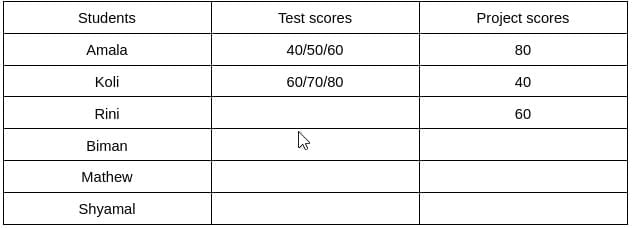 It is known that Amala had the highest aggregate score, and Shyamal scored the second highest on the test. He scored two more than Koli, but two less than Amala in the aggregate.
It is known that Amala had the highest aggregate score, and Shyamal scored the second highest on the test. He scored two more than Koli, but two less than Amala in the aggregate.
Hence, the score obtained by Shyamal in the test is 70, which implies Koli can't score 70 in the test => Amala can't score 50 in the test.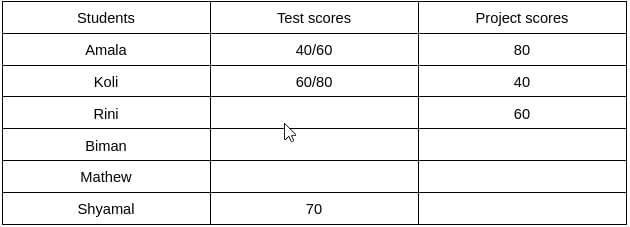 It is given that Shyamal scored two more than Koli, but two less than Amala in the aggregate. Hence, the aggregate score of Amala is 4 more than Koli. It is also known that Amala had the highest aggregate score.
It is given that Shyamal scored two more than Koli, but two less than Amala in the aggregate. Hence, the aggregate score of Amala is 4 more than Koli. It is also known that Amala had the highest aggregate score.
Case 1: The test score of Amala is 40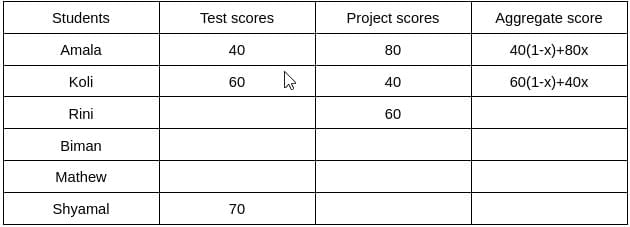
Therefore, 40 (1 - x) + 80x = 60 (1- x) + 40x + 4
⇒ 60x = 24
⇒ x = 0.4
Hence, the aggregate score obtained by Amala is 40 (1- 0.4) + 80 * 4 = 56
The minimum aggregate score of Shyamal is 70 (1 - 0.4) + 40 * 0.4 = 58, which is greater than Amala.
Hence, Case 1 is not possible.
Hence, the table is given below: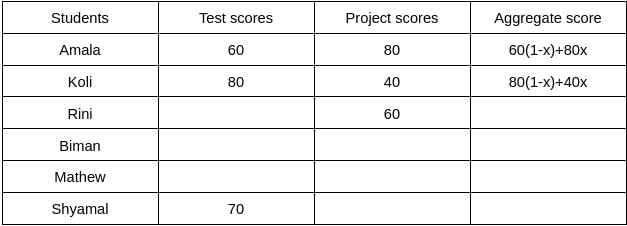 Therefore, 60 (1 - x) + 80x = 80 (1 - x) + 40x + 4
Therefore, 60 (1 - x) + 80x = 80 (1 - x) + 40x + 4
⇒ 60 + 20x = 84 - 40x
⇒ 60x = 24
⇒ x = 0.4
Hence, the aggregate score of Amala is 60(1-0.4)+80*0.4 = 68, which implies the aggregate score of Shyamal is (68 -2) = 66
Hence, the score obtained by Shyamal in Project is {66 - 70 * (0.6)} / 0.4 = 60.
It is also known that Biman scored second lowest in the test, which implies the score of Biman in the test is 50, and he scored the lowest in the aggregate. It is also known that Mathew scored more than Rini in the project, but less than her in the test. Hence, Mathew scored 80 in the project (since Rini scored 60 in the project), and Biman scored 40 in the project.
Similarly, Rini Scored more than Mathew on the test, which implies the score obtained by Rini is 60, and the score obtained by Mathew is 40 in the test.
Hence, the final table will look like this: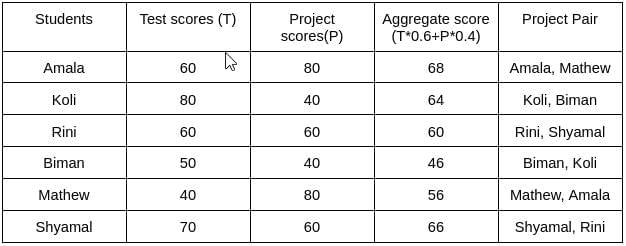 Hence, the maximum aggregate score obtained is 68. The correct option is A.
Hence, the maximum aggregate score obtained is 68. The correct option is A.
Q4: What was Mathew’s score in the test?
 View Answer
View Answer 
Ans: 40
It is given that there are only three female students - Amala, Koli, and Rini - and only three male students - Biman, Mathew, and Shyamal - in a course.
It is also known that the aggregate score in the course is a weighted average of the two components, with the weights being positive and adding to 1.
Let the project score component be x, which implies the test score component will be (1-x). The projects are done in groups of two, with each group consisting of a female and a male student, which implies there are three groups for the project. It is also known that both the group members obtain the same score in the project. The score obtained in the project is 40, 60, and 80, respectively.
Therefore, we can say that each female student will consist of a different group, and no two male students or female students will be in the same group.
For the test scores, there are six scores given for six students among which four are distinct and the remaining two are average scores, which is 60. It is also known that the maximum score possible is 80, and the minimum score is 40.
Hence, the distinct scores are 80, 70, 50, and 40 (since all the test scores are multiple of 10), and the remaining two scores are 60, and 60, respectively.
From point 3, we know that Amala’s score in the project was double that of Koli in the same, but Koli scored 20 more than Amala in the test. Hence, we can say the score obtained by Amala in the project is 80, and the score obtained by Koli is 40, which implies the score obtained by Rini in the project is 60. Now, Koli scored 20 more than Amala in the test, which implies the score obtained by Koli can be either 80, 70, or 60.
The score obtained by them is given below: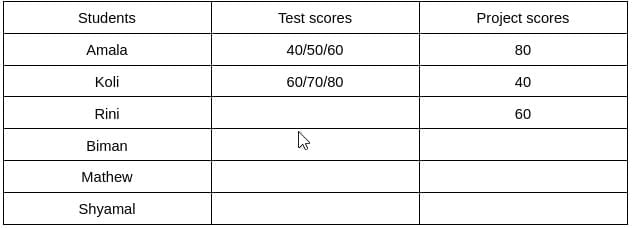 It is known that Amala had the highest aggregate score, and Shyamal scored the second highest on the test. He scored two more than Koli, but two less than Amala in the aggregate.
It is known that Amala had the highest aggregate score, and Shyamal scored the second highest on the test. He scored two more than Koli, but two less than Amala in the aggregate.
Hence, the score obtained by Shyamal in the test is 70, which implies Koli can't score 70 in the test => Amala can't score 50 in the test.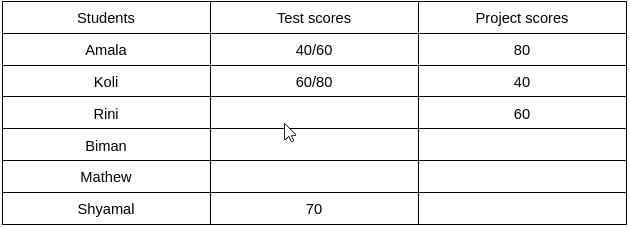 It is given that Shyamal scored two more than Koli, but two less than Amala in the aggregate. Hence, the aggregate score of Amala is 4 more than Koli. It is also known that Amala had the highest aggregate score.
It is given that Shyamal scored two more than Koli, but two less than Amala in the aggregate. Hence, the aggregate score of Amala is 4 more than Koli. It is also known that Amala had the highest aggregate score.
Case 1: The test score of Amala is 40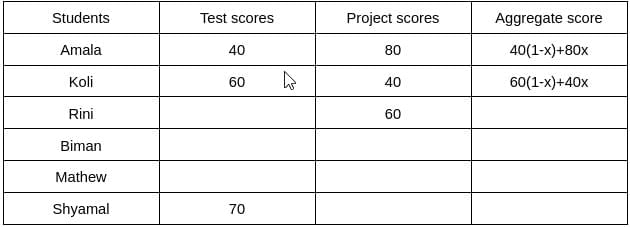
Therefore, 40 (1 - x) + 80x = 60 (1 - x) + 40x + 4
⇒ 60x = 24
⇒ x = 0.4
Hence, the aggregate score obtained by Amala is 40 (1 - 0.4) + 80 * 4 = 56
The minimum aggregate score of Shyamal is 70 (1 - 0.4) + 40 * 0.4 = 58, which is greater than Amala.
Hence, Case 1 is not possible.
Hence, the table is given below: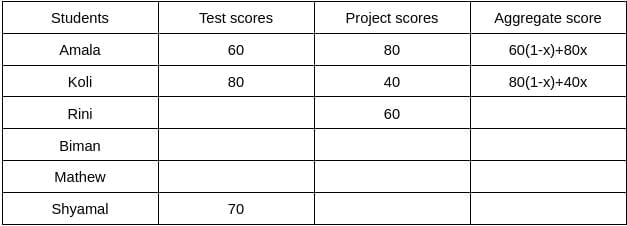 Therefore, 60 (1 - x) + 80x = 80 (1 - x) + 40x + 4
Therefore, 60 (1 - x) + 80x = 80 (1 - x) + 40x + 4
⇒ 60 + 20x = 84 - 40x
⇒ 60x = 24
⇒ x = 0.4
Hence, the aggregate score of Amala is 60 (1 - 0.4) + 80 * 0.4 = 68, which implies the aggregate score of Shyamal is (68 - 2) = 66
Hence, the score obtained by Shyamal in Project is {66 - 70 * (0.6)} / 0.4 = 60.
It is also known that Biman scored second lowest in the test, which implies the score of Biman in the test is 50, and he scored the lowest in the aggregate. It is also known that Mathew scored more than Rini in the project, but less than her in the test. Hence, Mathew scored 80 in the project (since Rini scored 60 in the project), and Biman scored 40 in the project.
Similarly, Rini Scored more than Mathew on the test, which implies the score obtained by Rini is 60, and the score obtained by Mathew is 40 in the test.
Hence, the final table will look like this: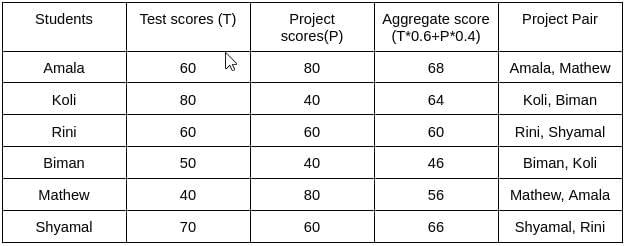 Hence, the score obtained by Mathew in the test is 40.
Hence, the score obtained by Mathew in the test is 40.
Q5: Which of the following pairs of students were part of the same project team?
(i) Amala and Biman
(ii) Koli and Mathew
(a) Only (ii)
(b) Only (i)
(c) Neither (i) nor (ii)
(d) Both (i) and (ii)
 View Answer
View Answer 
Ans: (c)
It is given that there are only three female students - Amala, Koli, and Rini - and only three male students - Biman, Mathew, and Shyamal - in a course.
It is also known that the aggregate score in the course is a weighted average of the two components, with the weights being positive and adding to 1.
Let the project score component be x, which implies the test score component will be (1-x). The projects are done in groups of two, with each group consisting of a female and a male student, which implies there are three groups for the project. It is also known that both the group members obtain the same score in the project. The score obtained in the project is 40, 60, and 80, respectively.
Therefore, we can say that each female student will consist of a different group, and no two male students or female students will be in the same group.
For the test scores, there are six scores given for six students among which four are distinct and the remaining two are average scores, which is 60. It is also known that the maximum score possible is 80, and the minimum score is 40.
Hence, the distinct scores are 80, 70, 50, and 40 (since all the test scores are multiple of 10), and the remaining two scores are 60, and 60, respectively.
From point 3, we know that Amala’s score in the project was double that of Koli in the same, but Koli scored 20 more than Amala in the test. Hence, we can say the score obtained by Amala in the project is 80, and the score obtained by Koli is 40, which implies the score obtained by Rini in the project is 60. Now, Koli scored 20 more than Amala in the test, which implies the score obtained by Koli can be either 80, 70, or 60.
The score obtained by them is given below: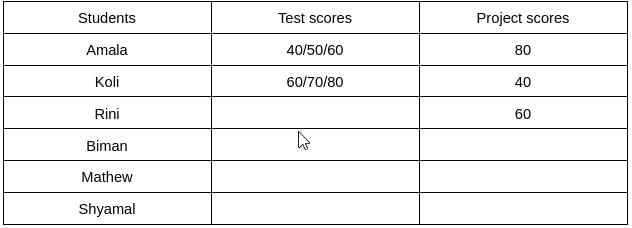 It is known that Amala had the highest aggregate score, and Shyamal scored the second highest on the test. He scored two more than Koli, but two less than Amala in the aggregate.
It is known that Amala had the highest aggregate score, and Shyamal scored the second highest on the test. He scored two more than Koli, but two less than Amala in the aggregate.
Hence, the score obtained by Shyamal in the test is 70, which implies Koli can't score 70 in the test => Amala can't score 50 in the test.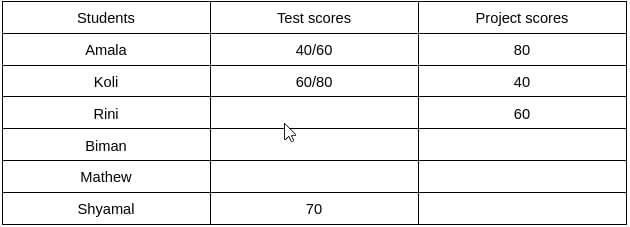 It is given that Shyamal scored two more than Koli, but two less than Amala in the aggregate. Hence, the aggregate score of Amala is 4 more than Koli. It is also known that Amala had the highest aggregate score.
It is given that Shyamal scored two more than Koli, but two less than Amala in the aggregate. Hence, the aggregate score of Amala is 4 more than Koli. It is also known that Amala had the highest aggregate score.
Case 1: The test score of Amala is 40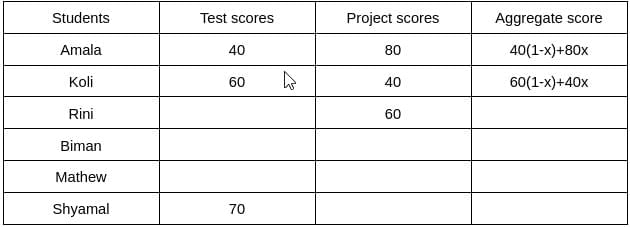
Therefore, 40 (1 - x) +80x = 60(1 - x) + 40x + 4
⇒ 60x = 24
⇒ x = 0.4
Hence, the aggregate score obtained by Amala is 40 (1 - 0.4) + 80 * 4 = 56
The minimum aggregate score of Shyamal is 70 (1 - 0.4) + 40 * 0.4 = 58, which is greater than Amala.
Hence, Case 1 is not possible.
Hence, the table is given below: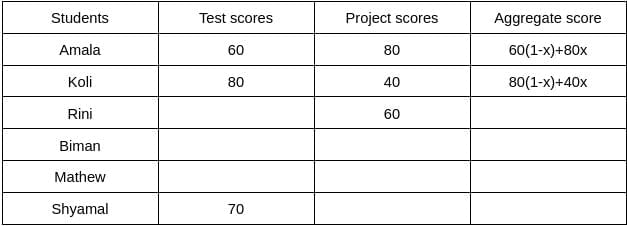 Therefore, 60 (1 - x) + 80x = 80 (1 - x) + 40x + 4
Therefore, 60 (1 - x) + 80x = 80 (1 - x) + 40x + 4
⇒ 60 + 20x = 84 - 40x
⇒ 60x = 24
⇒ x = 0.4
Hence, the aggregate score of Amala is 60 (1 - 0.4) + 80 * 0.4 = 68, which implies the aggregate score of Shyamal is (68 - 2) = 66
Hence, the score obtained by Shyamal in Project is {66 - 70 * (0.6)} / 0.4 = 60.
It is also known that Biman scored second lowest in the test, which implies the score of Biman in the test is 50, and he scored the lowest in the aggregate. It is also known that Mathew scored more than Rini in the project, but less than her in the test. Hence, Mathew scored 80 in the project (since Rini scored 60 in the project), and Biman scored 40 in the project.
Similarly, Rini Scored more than Mathew on the test, which implies the score obtained by Rini is 60, and the score obtained by Mathew is 40 in the test.
Hence, the final table will look like this: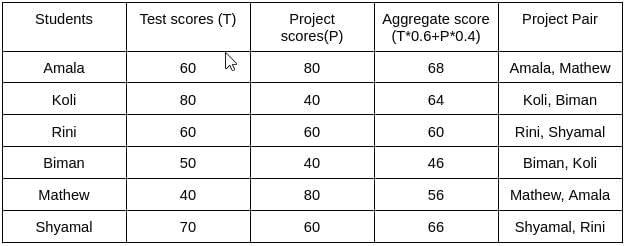 From the table, we can see that (Amala, Mathew), (Koli, Biman), and (Shyama, Rini) are the three groups for the project.
From the table, we can see that (Amala, Mathew), (Koli, Biman), and (Shyama, Rini) are the three groups for the project.
Hence, the correct option is C.
|
102 videos|123 docs|121 tests
|
FAQs on Practice Question - 52 (Tables) - 100 DILR Questions for CAT Preparation
| 1. What is the significance of data interpretation in competitive exams? |  |
| 2. How can I improve my skills in solving DI tables for exams? |  |
| 3. What types of questions are typically asked in DI tables in exams? |  |
| 4. Are there any specific strategies for time management while solving DI questions in exams? |  |
| 5. What resources or materials can I use to prepare for DI questions effectively? |  |















